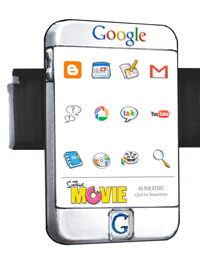 Pornography has always been a technology trendsetter — it stood on the VHS side of the videotape wars, was an innovator in streaming video content over the Internet, and was responsible for early breakthroughs for using credit cards as payment for Web transactions.
Pornography has always been a technology trendsetter — it stood on the VHS side of the videotape wars, was an innovator in streaming video content over the Internet, and was responsible for early breakthroughs for using credit cards as payment for Web transactions.
But no matter pornography’s contribution to technology, it’s mostly been relegated to the back room, out of sight, and rarely seen mingling with traditional, less “blue” content on mainstream devices.
That’s changing as Vudu, the set-top box that connects to a television and enables you to download and watch video content using a broadband connection, has signed a partnership deal with AVN Media Network.
 Vudu owners can download content from a new AVN channel — the first stand-along content channel on Vudu. The AVN Channel will feature standard and high-definition content from well-known adult video studios such as Wicked, Vivid, and Hustler.
Vudu owners can download content from a new AVN channel — the first stand-along content channel on Vudu. The AVN Channel will feature standard and high-definition content from well-known adult video studios such as Wicked, Vivid, and Hustler.
Standard definition movies can be rented for $6.99 and purchased for $19.99. High definition content costs $8.99 to rent, $29.99 to buy.
Adult video content has been included alongside mainstream content on hotel-room set-top boxes and on cable or satellite TV pay-per-view channels. There’s even a dedicated set-top box for the adult industry from FyreTV.
But the Vudu-AVN partnership has the potential to bring into the home, on the same device the family watches the latest Hollywood movies, a stunning amount of adult content in maybe too much detail.
Good thing there’s a slew of parental controls. You wouldn’t want little Johnny stumbling upon “Red Hot Chili Sex” and think it’s a movie about the Red Hot Chili Peppers.
 ESPN and Major League Baseball Advanced Media announced today that they have extended their new-media rights deal, allowing ESPN to stream live games on the Internet and add baseball content onto a number of platforms and devices.
ESPN and Major League Baseball Advanced Media announced today that they have extended their new-media rights deal, allowing ESPN to stream live games on the Internet and add baseball content onto a number of platforms and devices.


 As a voracious reader I am happy to see the success of the Kindle, Amazon’s electronic book reader. But no matter how many devices Amazon or others sell, the whole eBook reader thing is fundamentally flawed.
As a voracious reader I am happy to see the success of the Kindle, Amazon’s electronic book reader. But no matter how many devices Amazon or others sell, the whole eBook reader thing is fundamentally flawed. It’s been almost a year since I wrote “
It’s been almost a year since I wrote “ I’ve had the money in my wallet since July 11, but I refuse to spend it on iPhone 3G. And this really, really surprises me.
I’ve had the money in my wallet since July 11, but I refuse to spend it on iPhone 3G. And this really, really surprises me.

 Pornography has always been a technology trendsetter — it stood on the VHS side of the videotape wars, was an innovator in streaming video content over the Internet, and was responsible for early breakthroughs for using credit cards as payment for Web transactions.
Pornography has always been a technology trendsetter — it stood on the VHS side of the videotape wars, was an innovator in streaming video content over the Internet, and was responsible for early breakthroughs for using credit cards as payment for Web transactions. Vudu owners can download content from a new AVN channel — the first stand-along content channel on Vudu. The AVN Channel will feature standard and high-definition content from well-known adult video studios such as Wicked, Vivid, and Hustler.
Vudu owners can download content from a new AVN channel — the first stand-along content channel on Vudu. The AVN Channel will feature standard and high-definition content from well-known adult video studios such as Wicked, Vivid, and Hustler.